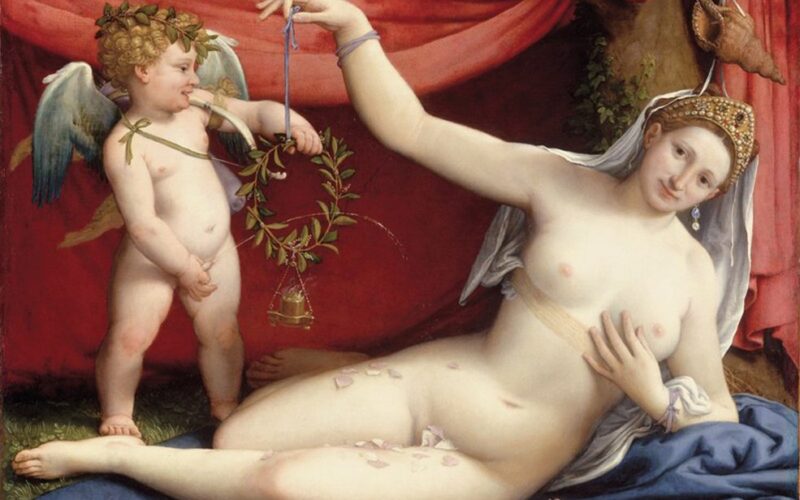At the zenith of the Renaissance, where art intertwines with mythology and spirituality, a painting emerges that encapsulates the essence of love in every shade: “Venus and Cupid Mingente” by Lorenzo Lotto. This work, steeped in symbolism and allegory, is a hymn to the celebration of amorous union, a masterpiece that defies the passage of time.
The artist, a true alchemist of colors and shapes, weaving together pagan classicism and Christian values, brings to life an Eros as a grape harvester who, with an irreverent but symbolically loaded gesture, showers the goddess Venus. This act, which might be mistaken for a mere expression of carefree innocence, actually holds a profound meaning: it is the water of life, the blessing of a love destined to be fruitful and enduring.
Approaching the work, details emerge that unveil the cultural depth of the era. The shell, strategically placed in the upper right corner, goes beyond mere decoration to become a powerful symbol of fertility. The rose petals adorning Venus’s body are not just a tribute to her divine beauty but also a nod to her feminine essence and divine nature.
The veil adorning the goddess’s head, embellished with a diadem, transcends its accessory function to become a nuptial symbol, a harbinger of love consummated in the sacrament of marriage. And Cupid’s jet? A reference to joyful and immaculate sensuality, an allusion to the consummation of love manifested in the fragmentation of the rose, an emblem of a feeling that disperses to give life to something new and vital.
The red drapery, the backdrop for the two protagonists, speaks of alchemy, of transformation and union of opposites, evoking the rubedo that symbolizes the culmination of a process of purification and synthesis. The tree trunk, the small serpent, the staff, and the incenses are all elements that together complete this visual narrative, each bringing a piece of the story that Lotto wishes to tell.
Lorenzo Lotto, in his roles as painter and alchemist, urges us to look beyond Cupid’s seemingly irreverent gesture, to decipher the meanings hidden in the symbols, to recognize the importance of the classical and religious culture that permeates the work. In this painting, every element is an invitation to ponder love, life, and the bonds that connect the human to the divine.
With these words, it is hoped to have sparked curiosity to delve deeper into the works of these exceptional artists, whose knowledge and mastery are unmatched in our contemporary times. “Venus and Cupid Mingente” is not merely a work of art; it is a window into a world where art is a means of knowledge, a bridge between the past and present, and an eternal celebration of love in all its expressions.
Marco Mattiuzzi












